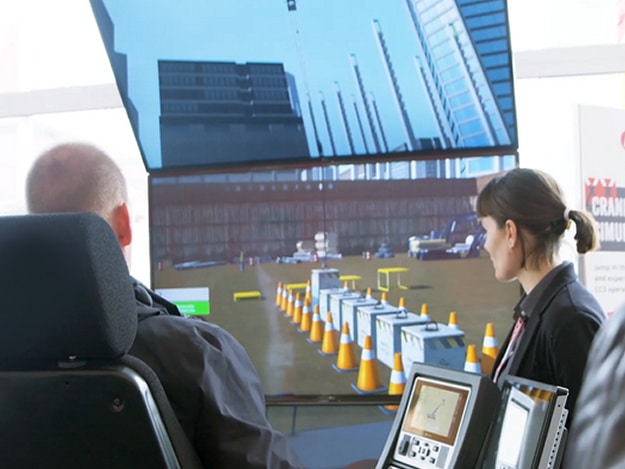CM Labs has developed branded Manitowoc crane training simulators to capture the feel and experience of operating a real crane.
With manufacturing facilities throughout North America, much of Manitowoc’s growth is attributed to the acquisition of brands such as Grove, National Crane, Potain, and Shuttlelift in the USA.
But diversity has its challenges and each product line has historically had its own engineering and design center. This created steep learning curves for operators as they encountered different Manitowoc crane models.
To resolve this, an initiative was launched to standardize controls across the Manitowoc line of cranes. Found on virtually every Manitowoc crane, the Crane Control System (CCS) provides a common look and feel from an operational perspective. The objective is to provide customers with equipment usage flexibility by reducing much of the training normally required to operate an unfamiliar crane.
“With the CCS, regardless of which model you’re talking about, control inputs are very similar,” Manitowoc Director of Service, Training & Telematics John Alexander says.
“For example, this allows an operator to run one of our all-terrain cranes and then jump into a rough-terrain crane and have the same functionality, feel, and control inputs.”
Another benefit lies with engineering and product development. Commonality behind the core programming language of the control system inputs, is allowing Manitowoc’s global engineering community to freely share information and make enhancements throughout product lines.
Training innovation
Training plays a key role in the market’s adoption of any new initiative, and CCS is no exception.
“Even twenty years ago, machines were built without all of today’s sophisticated program control system inputs,” Alexander says.
“Functions were straightforward and operated through lever action. But now cranes are controlled digitally, making operation more complex. What’s more, there are unique distinctions from one model to another that an operator has to be comfortable with. That’s why it’s critical to have well-trained operators in the seats of newer cranes, and the more standardisation across models, the easier that becomes.”
When it comes to effective training, nothing beats hands-on interaction with physical equipment and controls invaluable. But field training with any piece of equipment – especially a crane – is costly and can be logistically impractical
“Training simulators, on the other hand, offer a cost-effective alternative that is both practical and efficient.
“We had been interested in simulation-based training and impressed with CM Labs technology for a long time,” Alexander says.
Manitowoc is taking full advantage of its CM Labs simulators. Training can also be adapted to the unique requirements and experience of each operator. A veteran operator may require just a quick tutorial to become familiar with the inputs, while a novice will require considerably more training time.
Through CM Labs simulators, Manitowoc is also providing an opportunityfor trade show visitors to experience their equipment right on the show floor.
“Simulators allow for demonstrating picks, swinging, and other operations that are not permitted at a show. Attendees can take the controls in hand and run the crane through its paces in a controlled, yet realistic, environment.”



